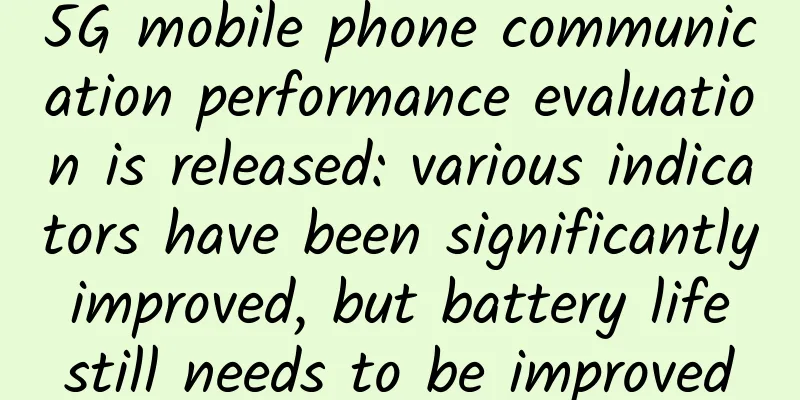5G mobile phone communication performance evaluation is released: various indicators have been significantly improved, but battery life still needs to be improved

|
In terms of 5G mobile phone communication performance evaluation, 52 5G full-network mobile phones from 10 brands were evaluated for 278 hours on 87 indicators under the 5G performance, Wi-Fi performance, GNSS performance, gaming and other heavy-load business performance, and battery life performance evaluation system. In terms of 5G performance evaluation, the average downlink rate of the 5G mobile phones evaluated in this issue exceeded 900Mbps in the SA live network, an increase of 10% over the previous issue; the dynamic PING latency performance of the live network has been slightly improved compared with the previous issue, and the average timeout ratio has been reduced by 4%; the overall operation stability of 5G mobile phones has been significantly improved, an increase of 25% over the previous issue; the overall data performance of 5G mobile phones in dynamic scenarios is poor, and the mobile phones with the same chip platform vary greatly, with the maximum difference of 110%. Judging from the evaluation results, Xiaomi mobile phones have outstanding 5G performance and have made great progress. Suggestions for improving 5G performance include further optimizing 5G modem and antenna performance to increase the 5G gigabit service radius; strengthening the optimization of mobile phone SA switching performance to improve the average rate of 5G mobile phones in dynamic scenarios; the overall operating stability of 5G mobile phones still has a lot of room for improvement, and it is recommended to increase investment. In terms of Wi-Fi performance evaluation, thanks to the significant increase in Wi-Fi 6 support (77%), the average uplink and downlink peak rates of the current models (807Mbps/862 Mbps) increased by 38.3% and 35% respectively compared with the previous period; the uplink and downlink rates of models supporting 160M bandwidth (accounting for 42.5% of Wi-Fi 6 models) increased by 69% and 79% respectively compared with those not supporting 160M; Wi-Fi 5 models (accounting for 23%) do not support dual antennas, and the average uplink and downlink peak rates are lower (379 Mbps/359Mbps). Judging from the evaluation results, Honor and Xiaomi have relatively better Wi-Fi performance. Wi-Fi 6 mobile phone experience has obvious advantages, and the industry chain is recommended to continue to promote the process of 5G mobile phones supporting Wi-Fi 6. The wireless environment of the 5G frequency band is relatively pure, creating conditions for 160M bandwidth channels. Currently, only a few platforms (Snapdragon 888 and 778G) support it. It is recommended that the industry chain further increase the support rate of 160M bandwidth and make full use of spectrum resources to provide Gigabit Wi-Fi experience. In terms of GNSS performance evaluation, all 5G mobile phones support Beidou independent positioning capabilities, but 72% of models still do not turn on the Beidou independent positioning function by default; the average Beidou independent positioning accuracy of 5G mobile phones is 1.5m, an increase of 44% over the previous period; the gap between capture sensitivity and recapture time and GPS is significantly narrowed. The navigation positioning accuracy in complex environments such as high-rise buildings, tunnels, and elevated areas has improved by 23% to 52% over the previous period. Judging from the evaluation results, Honor's GNSS performance is better overall. At present, Beidou positioning has become the dominant positioning capability of mobile phones. 5G mobile phones should turn on the Beidou independent positioning function by default and further optimize Beidou positioning performance. In addition, GNSS performance does not only rely on chips. Mobile phone manufacturers should also strengthen the continuous optimization of antenna performance and software algorithms to comprehensively improve Beidou positioning performance. In terms of game performance evaluation, in a Wi-Fi interference environment, the game latency and stuttering rate of 5G mobile phones have been significantly improved compared with the previous period, with latency reduced by 15% and stuttering rate reduced by 70%; the proportion of mobile phones supporting high refresh (≥90 frames) is as high as 88%, and the average frame rate of "Peace Elite" has been significantly improved; the temperature rise of mobile phones when playing games is relatively high. After playing "Peace Elite" for 45 minutes at room temperature (25℃), the surface temperature of 23% of models exceeded 50℃. The evaluation results show that the overall performance of vivo and OPPO mobile phones in gaming is excellent. Subsequently, it is recommended to continuously optimize the game latency performance and gaming experience according to the traffic model of mainstream games, targeting typical Wi-Fi interference environments and 5G weak signal environments, thereby improving smoothness while controlling phone heating and power consumption. In terms of battery life performance evaluation, the battery life of 5G mobile phones has increased by 4.5% compared with the previous period, and the average battery life is over 10 hours under high-intensity business models; thanks to the development and popularization of fast charging technology, the average time it takes for 5G mobile phones to be fully charged has been shortened from 88 minutes to 62 minutes, a reduction of about 30%. The evaluation results show that vivo and OPPO mobile phones have outstanding overall performance in terms of battery life performance, and have excellent and balanced performance in terms of battery capacity, power consumption management and fast charging technology. Overall, the battery life has not been significantly improved. It is recommended that the industry chain continue to invest in reducing the power consumption of 5G chips, increasing battery power, and optimizing power management algorithms. At the same time, there is still room for further improvement in fast charging technology. It is recommended that the industry chain actively increase the popularity of high-power fast charging technology. The report pointed out that based on the performance of 5G, Wi-Fi, GNSS, gaming and battery life, Honor Magic 3 Pro, Honor Magic 3, OPPO Reno6 Pro and Redmi Note 9 ranked first in the four price segments respectively. In terms of brands, Honor is in the lead overall, while OPPO, vivo and Xiaomi also performed well. |
Recommend
Little Red Book Promotion Notes Marketing Strategy!
If you ask me which platform users enjoy watching...
The blender is too cruel! The Apple Watch instantly turned into dregs
A few days ago, we gave the Apple Watch a scratch...
Application of workflow engine in vivo marketing automation
Author: Cheng Wangrong, vivo Internet Server Team...
Recommended contact information for part-time delivery of high-end tea tasting in Wuhan
The contact information of Wuhan Three Towns Tea ...
When returning home for the Spring Festival, beware of carbon monoxide poisoning!
As the Spring Festival approaches, people who wor...
How much does it cost to attract investors for the Baise Car Moving App? What is the investment price for Baise Car Moving App?
How much does it cost to attract investment in th...
For bidding promotion, just read this article!
Today, based on years of experience in bidding pr...
Is there any difference between Google optimization and Baidu optimization? How to do Google SEO well?
Why is my SEO promotion not effective? This is th...
How long is the best time to warm up your car in winter? 30 seconds or 3 minutes? Experienced drivers: This is the best way
As the cold wave hits most cities across the coun...
World Allergy Day | Contemporary “allergy crisis”: Why are our bodies becoming more and more sensitive?
Today is World Allergy Day. Every year on July 8,...
American warriors used "magic stones" to fight, which were as lethal as iron weapons
Reviewer: Ma Zhifei Geological science writer, se...
Why is the number of views always low? Five data indicators that short video operators need to pay attention to
Data analysis is a very necessary part in short v...
MoKee OpenSource 51.1 2015-07-25 Officially released!
MoKee OpenSource 51.1 2015-07-25 Official version...
Be careful when installing and configuring server hosting yourself
When you are hosting a server, if you install and...
If there are few “half moons” on the nails, does it mean that your body is unhealthy?
There are many rumors about the half-moons on the...









